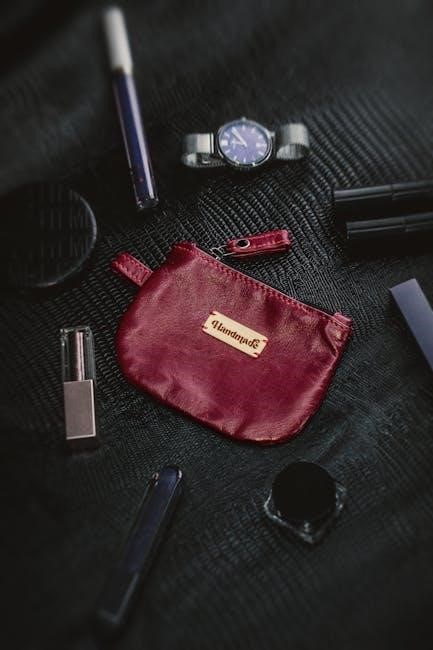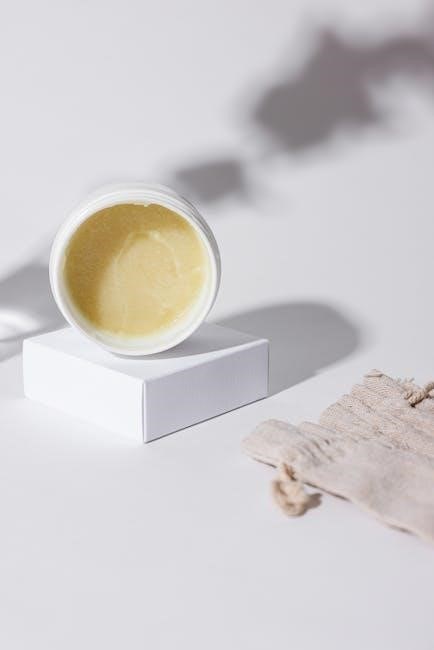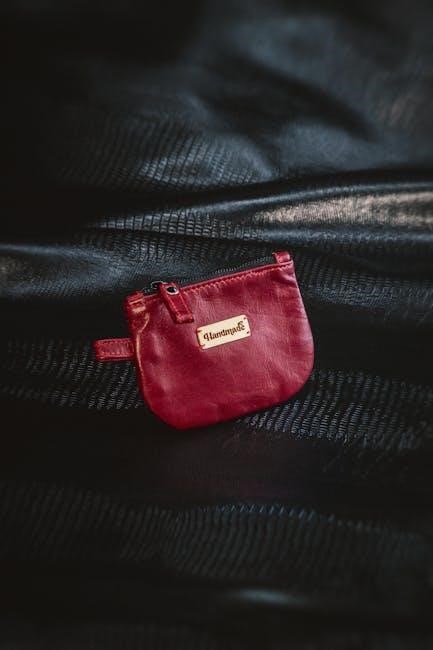
Learn to create a versatile zippered pouch‚ perfect for organization and gifting. This DIY project offers endless customization and is ideal for practicing zipper installation and sewing techniques.
Overview of the Project
This tutorial guides you through creating a practical and stylish zippered pouch. Perfect for beginners‚ it requires basic sewing skills and tools like a machine‚ scissors‚ and pins. The project involves measuring‚ cutting fabric‚ and attaching a zipper for a secure closure. You’ll learn to construct both the outer pouch and lining‚ ensuring a professional finish. The pouch can be customized with fabric designs‚ making it ideal for personal use or as a thoughtful gift. It’s a great way to practice working with zippers and sewing boxed corners for a polished look.
Importance of Zippered Pouches in DIY Sewing
Zippered pouches are a versatile and practical DIY sewing project‚ offering endless customization options. They serve as excellent organizational tools for daily essentials and make thoughtful gifts. Sewing a zippered pouch helps beginners master foundational skills like zipper installation and working with linings. It’s also a great way to practice precise sewing techniques and enhance creativity. The process builds confidence and hones sewing abilities‚ making it a rewarding project for crafters of all skill levels. Plus‚ the finished pouch is both functional and stylish‚ encouraging experimentation with fabrics and designs.

Materials and Tools Needed
Gather fabric for outer and lining‚ a zipper‚ sewing machine‚ scissors‚ pins‚ measuring tape‚ rotary cutter‚ mat‚ and iron for a smooth sewing experience.
Fabric Requirements for Outer and Lining
For a zippered pouch‚ choose durable‚ medium-weight fabrics like cotton or canvas for the outer layer. The lining can be a lighter fabric‚ such as quilting cotton‚ to add a pop of color. Ensure both fabrics are pre-washed to prevent shrinkage. Use scraps for a patchwork look or coordinate solids for a sleek design. The outer fabric should match the lining in texture for a professional finish. Measure and cut accurately to ensure enough material for the pouch’s size and style.
Zipper Selection and Size
Selecting the right zipper is crucial for your pouch’s functionality. Choose a zipper that matches the pouch’s size and desired aesthetic. Nylon or metal zippers work well‚ depending on the project. Ensure the zipper length aligns with the pouch’s opening for smooth operation. For a professional finish‚ consider adding zipper tabs to conceal raw edges. Proper zipper size ensures ease of use and a polished look‚ making your pouch both functional and visually appealing.
Additional Tools: Sewing Machine‚ Scissors‚ Pins
Besides fabric and zippers‚ essential tools include a sewing machine for stitching‚ sharp scissors for precise cutting‚ and pins to secure fabric layers. A seam ripper is handy for corrections‚ while an iron ensures crisp folds. Optional tools like a zipper foot or rotary cutter can enhance accuracy. These basics help streamline the process‚ ensuring a professional finish and making your sewing experience more efficient and enjoyable.

Understanding Zipper Basics
Mastering zipper fundamentals is key to a polished pouch. Learn about zipper types‚ tab attachments‚ and proper alignment to ensure a smooth‚ professional installation every time.
How to Insert a Zipper Properly
Align the zipper edges with the fabric‚ ensuring the teeth face inward. Pin securely‚ then sew along both sides using a zipper foot for precision. Backstitch at the start and end for durability. Trim excess fabric carefully and press the seams for a professional finish. Proper zipper insertion ensures smooth functionality and a polished look‚ essential for a sturdy and attractive pouch.
Zipper Tab Tutorial for a Professional Finish
A professional finish begins with a well-crafted zipper tab. Start by pressing your zipper tab fabric in half lengthwise. Open the fold and bring the raw edges to the center‚ creating a symmetrical tab. Fold again and sew along the edge. Attach the tab to the zipper ends‚ ensuring alignment for a clean look. This technique prevents fraying and adds a polished touch. Secure the tab by sewing firmly at the base. A neat zipper tab elevates the pouch’s aesthetics and functionality‚ making it look store-bought.

Measuring and Cutting Fabric
Precise measurements ensure a professional finish. Measure fabric for pouch sides accurately‚ leaving 1/4 inch for seams. Cut outer and lining fabrics separately‚ ensuring alignment for a polished result.
Accurate Measurements for Pouch Sides
Measuring fabric accurately is crucial for a professional-looking pouch. Ensure both outer and lining fabric sides match in size‚ adding seam allowances as specified. Trim excess fabric carefully‚ leaving a consistent margin around edges. Press seams flat to maintain shape and alignment. Proper measurements guarantee a smooth fit and even construction‚ essential for functionality and aesthetics. Double-check cuts before sewing to avoid mismatches‚ ensuring a polished final product.
Cutting Lining and Outer Fabric
Cutting fabric accurately is crucial for a professional finish. Measure and cut two main pieces for the outer fabric and two for the lining‚ ensuring they match in size. Add seam allowances and zipper space. Use rotary cutters and mats for precision. Cut lining slightly smaller to prevent bulk. Fold fabric neatly to avoid stretching. Double-check measurements before cutting to ensure alignment during sewing. This step sets the foundation for a well-made pouch‚ so attention to detail is key.

Attaching the Zipper
Align the zipper with the fabric edges‚ pin securely‚ and sew along both sides. Use a zipper foot for smooth stitching‚ ensuring even pressure and alignment.
Aligning Zipper with Fabric Edges
To ensure a professional finish‚ align the zipper carefully with the fabric edges. Place the zipper along the top edge of the outer fabric‚ centering it for symmetry. Pin the zipper in position‚ ensuring the teeth align with the fabric’s edge. Repeat the process for the lining‚ making sure the zipper is face down on the outer fabric and face up on the lining. This proper alignment guarantees a seamless integration of the zipper into the pouch design‚ creating a polished and functional accessory.
Sewing the Zipper in Place
Align the zipper with the fabric edges‚ ensuring it is centered and evenly spaced. Place the zipper face down on the fabric‚ pin it securely‚ and sew along the edge using a 1/4-inch seam allowance. Use a zipper foot for precise stitching and backstitch at the beginning and end for durability. After sewing‚ flip the fabric right side up and press the seam to create a crisp finish. This step ensures the zipper is securely attached and functional‚ providing a professional look to your pouch.

Sewing the Pouch Body
Construct the outer pouch by sewing the sides together‚ ensuring proper alignment. Add the lining‚ leaving a small opening for turning the pouch right side out.
Constructing the Outer Pouch
Place the outer fabric pieces right sides together‚ ensuring alignment of edges. Sew the sides and bottom‚ leaving a small opening for turning the pouch right side out. Align the zipper with the top edges of the outer fabric‚ then sew in place securely. Trim excess fabric and press seams for a crisp‚ professional finish. This step forms the structural foundation of the pouch‚ preparing it for the next stages of assembly.
Adding Lining to the Pouch
Attach the lining by placing it inside the pouch‚ aligning edges with the outer fabric. Sew around the edges‚ leaving a small opening to turn the pouch right side out. Press seams for a crisp finish‚ ensuring the lining lies flat. This step hides raw edges and gives a professional look. Proper alignment and smooth sewing ensure the lining stays in place‚ enhancing the pouch’s durability and appearance.

Creating Boxed Corners
Boxed corners enhance the pouch’s structure‚ providing a flat bottom. Sew across corners at a 90-degree angle‚ then trim excess fabric for a crisp‚ professional finish.
How to Sew Boxed Corners for a Flat Bottom
To achieve a flat bottom in your zippered pouch‚ sew boxed corners by marking and stitching squares at each corner. This technique ensures a professional finish and adds functionality. Trim excess fabric carefully and press seams for a crisp look. Boxed corners provide structural integrity and a polished appearance‚ making your pouch both durable and visually appealing. Follow precise measurements for consistent results‚ and use a ruler or template for accuracy. This step elevates your pouch from basic to bespoke‚ perfect for everyday use or gifting.
Turning the Pouch Right Side Out
Once sewn‚ carefully turn the pouch right side out through the opening in the lining; Trim excess fabric‚ ensuring a clean finish before pressing seams.
Trimming Excess Fabric
After sewing‚ carefully trim excess fabric to create a clean finish. Use sharp scissors to cut close to the stitching‚ ensuring not to cut too close to the seams. This step reduces bulk‚ especially around corners and zipper edges. Trim zipper tabs evenly for a polished look. Be precise to avoid cutting into the stitching‚ as this could weaken the pouch’s structure. Trimming excess fabric ensures a professional appearance and prepares the pouch for turning right side out; This step is essential for a neat‚ finished product.
Pressing the Seams for a Professional Look
After turning the pouch right side out‚ press all seams with a hot iron and steam to ensure a crisp‚ professional finish. This step flattens the fabric and creates sharp edges.
Pay special attention to the lining and outer fabric seams‚ pressing them separately before topstitching. A well-pressed pouch will look polished and elevate your DIY project to the next level.

Topstitching the Edges
Topstitching adds a professional finish to your zippered pouch. Using a contrasting thread color‚ sew along the edges of the pouch‚ ensuring straight‚ even stitches. This step enhances durability and creates a polished look. Start by threading your machine with a coordinating thread and sew about 1/8 inch from the edge. Topstitching not only reinforces seams but also makes the pouch stand out. Pay special attention to zipper edges for a crisp‚ clean appearance; This final touch elevates your handmade pouch to a professional level.

Adding a Strap or Handle
Add functionality and style with an optional strap or handle‚ perfect for easy carrying. This step enhances usability while maintaining the pouch’s aesthetic appeal and practicality.
Optional Strap Tutorial
Add functionality and style to your zippered pouch with a custom strap. Cut a strip of fabric to your desired length‚ fold it in half lengthwise‚ and sew along the edge. Turn the strap right side out‚ press the seams‚ and attach it to the pouch edges using pins or clips. For a polished look‚ topstitch the attachment points. This optional feature enhances usability and personalizes your pouch. You can also use a pre-made strap or ribbon for a quick finish. A loop turner tool can help if sewing thin straps.

Final Tips for Beginners
Start with simple patterns and practice zipper insertion. Watch tutorials for clarity‚ and don’t hesitate to trim excess fabric for a polished finish. Confidence grows with each stitch!
Common Mistakes to Avoid
When sewing a zippered pouch‚ avoid improper zipper alignment and insufficient pinning‚ which can lead to uneven seams. Not trimming excess fabric before turning the pouch right side out can cause bulkiness. Forgetting to leave an opening for turning or pressing seams before sewing can result in puckering. Additionally‚ rushing the topstitching step may lead to uneven stitching. These mistakes can compromise the pouch’s professional finish and functionality‚ so attention to detail is key for a polished result.
Customizing Your Pouch with Fabric Designs
Customizing your zippered pouch with unique fabric designs allows you to add a personal touch. Choose bold patterns‚ vibrant colors‚ or themed prints to make your pouch stand out. Mixing complementary fabrics creates a stylish contrast‚ while patchwork designs offer a quirky‚ handmade look. Experiment with quilting or embroidery for added texture. Personalized fabric choices ensure your pouch reflects your personality‚ making it a one-of-a-kind accessory. This step is where creativity shines‚ allowing you to transform a simple project into a truly special item.
Congratulations! You’ve successfully created a functional and stylish zippered pouch. This project offers a sense of accomplishment and encourages creativity for future DIY sewing endeavors.
Final Thoughts on Sewing a Zippered Pouch
Sewing a zippered pouch is a rewarding DIY project that combines practicality with creativity. It’s an excellent way to practice working with zippers and lined bags. The sense of accomplishment from creating something functional and personalized is unmatched. Whether for personal use or as a gift‚ a handmade pouch carries a special touch. Experiment with fabrics‚ sizes‚ and styles to make each piece unique. This project is a great confidence-builder for sewists of all skill levels‚ encouraging continued exploration in the world of sewing.
Encouragement to Experiment with Variations
Now that you’ve mastered the basics‚ it’s time to explore endless variations! Personalize your zippered pouches with unique fabric choices‚ colorful zippers‚ or decorative stitching. Add functionality by incorporating pockets or adjustable straps. Experimenting with different shapes and sizes can also create one-of-a-kind designs. Every variation is an opportunity to enhance your creativity and refine your sewing skills. Don’t hesitate to try new techniques—you’ll be amazed at how versatile this project can be! Find inspiration online or sketch your ideas to create truly personalized pouches.
Leave a Reply
You must be logged in to post a comment.